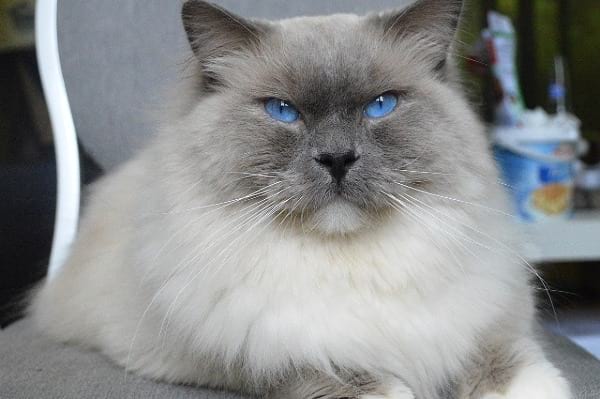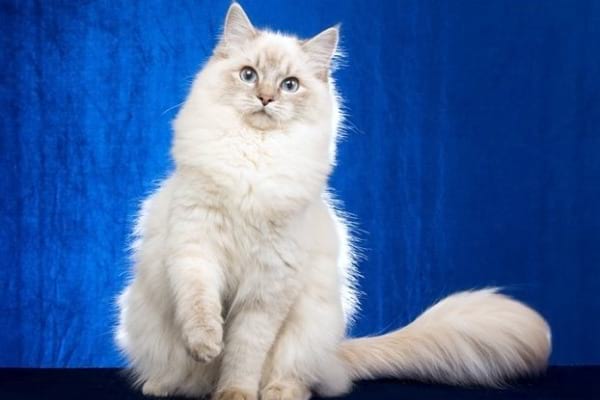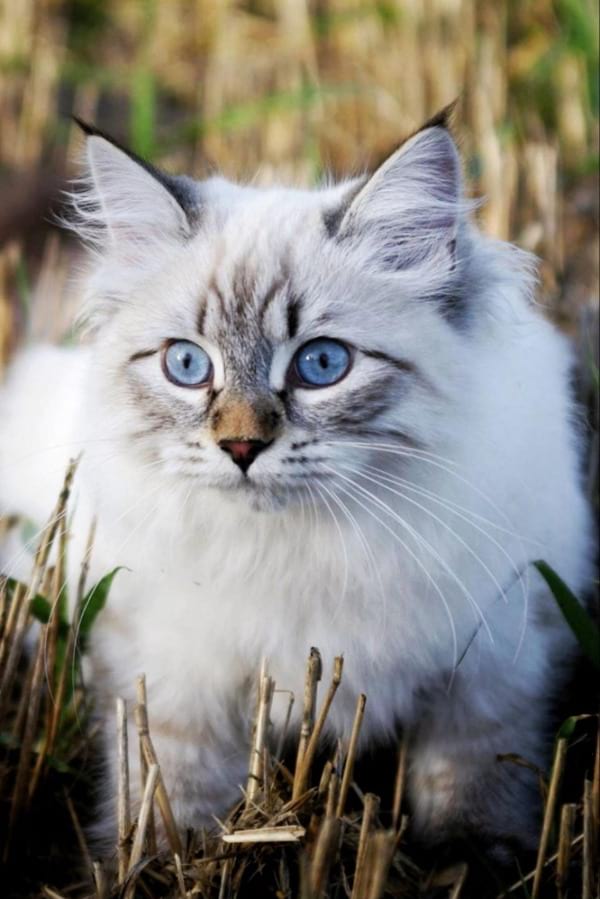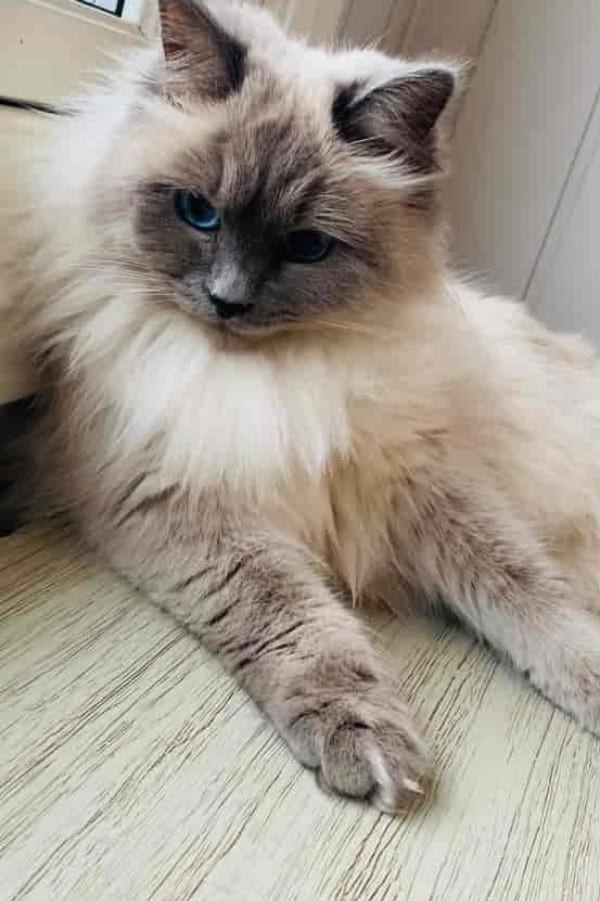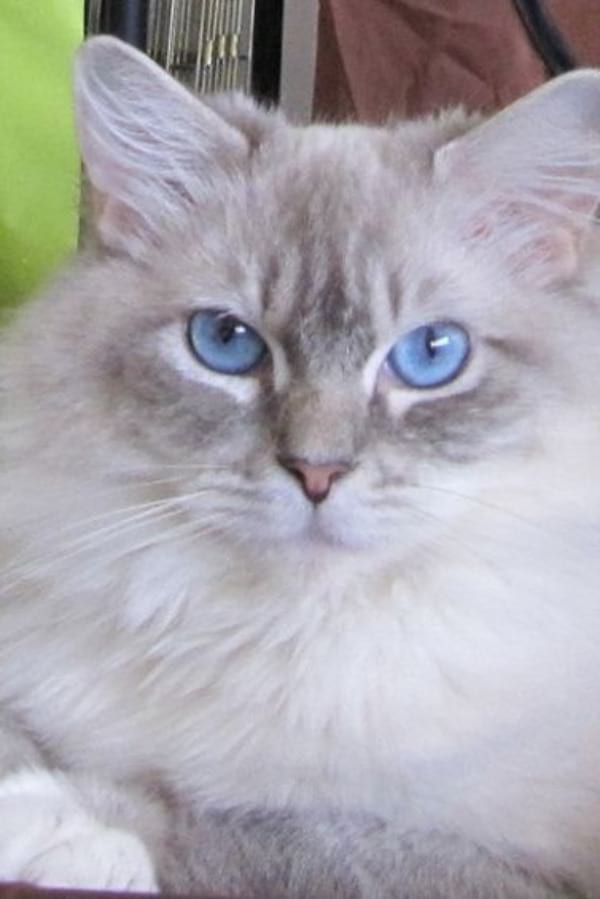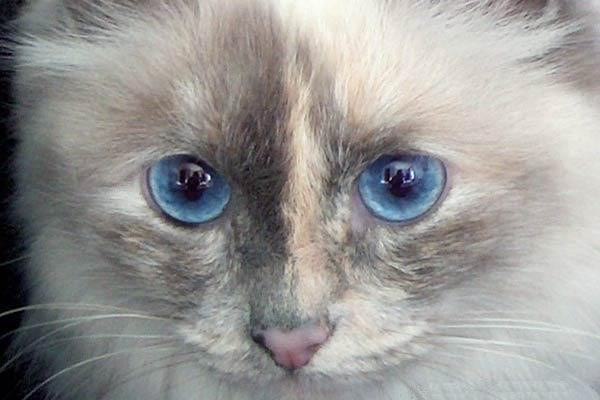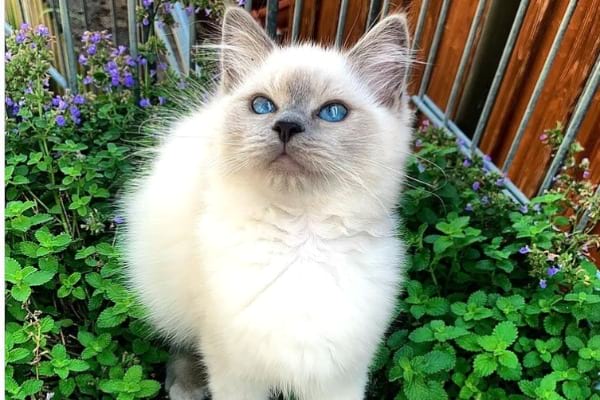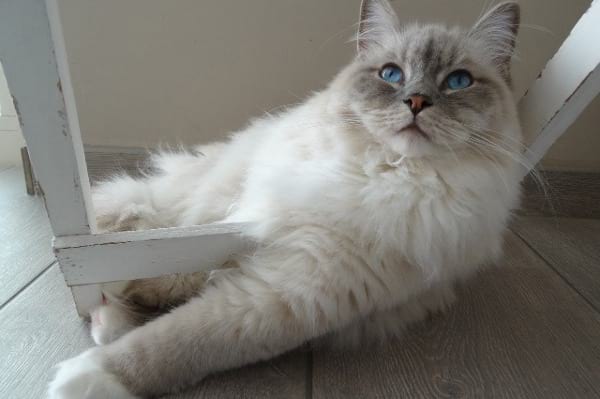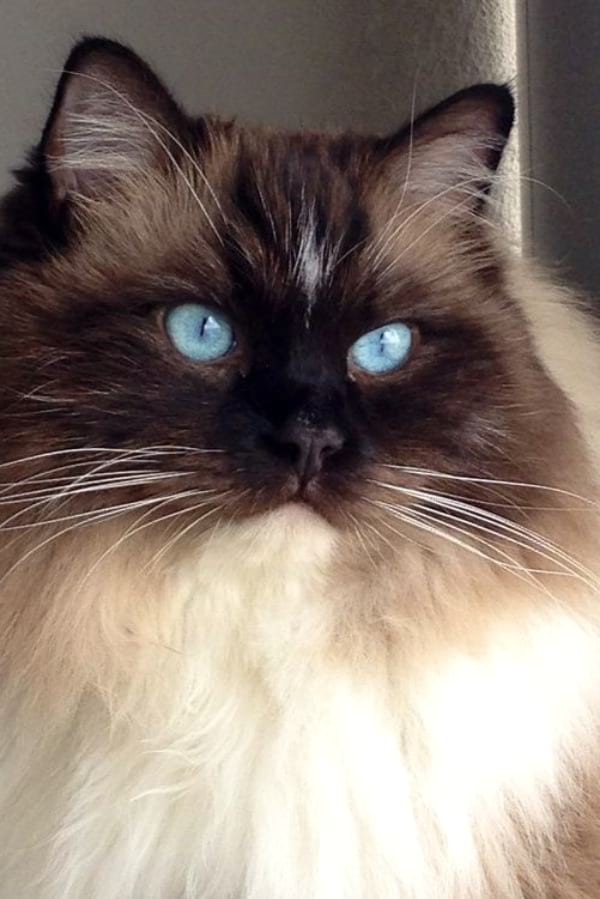The Ragdoll is an exceptional cat breed combining noble appearance and outstanding character traits. This touching pet with angelic eyes of piercing blue color, despite its aristocratic look, isn’t picky about life conditions. The beauty and loyalty of these cats haven’t gone unnoticed by people, and today the Ragdolls are among the most popular breeds in the world.
What Is a Blue Point Ragdoll Cat?
A blue pointed Ragdoll cat is one of the traditional colors of the Ragdoll breed. This cat has gray-colored ears, nose, paws, and tail. The body color can vary from light to dark gray depending on genetics, geographic location, and diet.
Temperament & Intelligence of the Blue Point Ragdoll Cat
The blue point cat is incredibly calm and friendly. These animals may seem lazy and phlegmatic, but they aren’t. The cats’ state of mind can be characterized as peaceful. Ragdoll kittens feel comfortable when the owner is nearby. These cats are lovingly related to all family members, and they like to “talk” to them, caressing them at the same time with their gentle deep gaze.
Are These Cats Good for Families?
Any blue point kitten is great with kids. Of course, different Ragdolls have different personalities depending on their upbringing and life experience. They are very peaceful and cannot be annoyed even by noisy children who treat them like toys and carry them around. Cats relax and stay patient even if such games can be dangerous.
Does This Breed Get Along with Other Pets?
The calm Ragdoll cats personality allows them to get along with all the family members easily, including other cats and dogs. They don’t mind living even with birds and fish without arousing their predatory instincts.
According to the classification established by world felinological organizations, there are several original and beautiful Ragdoll colors.
Blue Point Ragdolls
Ragdoll blue point cats have bluish-white bodies of cool colors with shadows, gradually turning white on bellies and chests. Blue point Ragdolls have bluish-colored eye patches and gorgeous blue eyes.
Blue Lynx Point Ragdolls
The blue lynx point Ragdoll kitten has a bluish-white, platinum-colored fur. The ears have deep bluish-gray tones with a lighter shade in the central part. The nose can be gray, but a cool pink color is preferred.
Blue Cream Lynx Point Ragdolls
The cat’s fur is bluish-white with platinum coloring in cool tones, with shadows transitioning to lighter and lighter shades in the belly and chest areas. The nose, as well as the paw pads, are dark gray.
Blue Cream Point Ragdoll
Looking through blue Ragdoll cat photos, you may notice that the cat’s body is pure white with some darkening in stripes. The ears are pale, light pink, with a pale center part. Blue point Ragdolls have coral pink paw pads and a pink nose.
Blue Colorpoint Lynx Ragdoll Cats
A Ragdoll lynx has a fur of the standard white color. The eye area is characterized by the pale-gray coloring with a gently pinkish hue. The eyes are deep blue, the nose is coral pink, and their paws are dark.
Blue Lynx Bicolor Ragdoll Cats
Blue lynx bicolor Ragdoll is known for its ivory-colored body coat with light streaky darkening. The cat’s eyes patches are of a warm grey coloration on a lighter colored background. Blue Ragdolls have a dark nose that looks great with gorgeous blue eyes.
Blue Lynx Mitted Ragdoll Cats
The body has shades of pale yellow to a darkish color. Warm tones characterize its fur. The base color gradually fades to light in the belly and chest. Blue mitted Ragdolls have a little white chin, deep blue eyes, and a pink nose. Blue mitted Ragdoll kittens look incredibly cute because they are wearing white mitts.
Blue Tortie Ragdoll Cats
The basic coloring is pale yellow or creamy, with light shadows on the belly and chest. The nose and paw pads are dark brown or pinkish coral colored with speckles.
Blue Colorpoint or Blue Point Ragdoll Cats
Blue colorpoint Ragdoll cats have dark-colored tails and ears, a dark-colored muzzle, and the lower part of the paws. This characteristic dark color is combined with the light shades of fur on the rest of the body.
Blue Bicolor Ragdoll Cats
This coloration is one of the most popular Ragdoll cat colors. A blue bi color Ragdoll has dark markings just like the color point cats, but the cats have white patches between the eyes that cover the entire muzzle.
Blue Mitted Ragdoll Cats (Blue Colorpoint Mitted Ragdoll Cats)
Blue point mitted Ragdoll pets have a basic light coloring combined with darker colored markings resembling colorpoint coloring. There’s white fur on the paws, chin, belly, and collar.
Blue Mitted Ragdoll Cats with Blazes
Blue point Ragdoll kitten “in mittens” has a pale-colored fur and blazes on the chest and belly. Besides, a blaze is found on their faces. Shading can be in the form of stripes or cream speckles. The ears are dark brown with a light central part.
Blue Point Ragdoll Color Genetics
Ragdolls all have genes that control the coloring of their fur. They have dominating colors such as seal (or black), red, cinnamon, and chocolate, as well as recessive or diluted hues such as blue, lilac, fawn, and cream.
The combination of the seal or black “B-gene” and the “D-gene” manifests in undiluted hues. The “b-gene” is associated with chocolate coloration, and the “d-gene” is responsible for diluted shades.
Simply said, the “B-gene” is in charge of color, whereas the “D-gene” is in charge of dilution. Each gene has two alleles or forms: B and b for either seal or chocolate, and D or d for either undiluted or diluted. A blue pointed Ragdoll has a combination of a “B-gene” and a completely developed undiluted “d-gene.”
Things to Know When Owning a Blue Point Ragdoll Cat
Each cat has its nature, so you should better know the Ragdolls.
Food & Diet Requirements
It is essential to feed your Blue Point Ragdoll cat a nutritious diet. Since it is a bigger cat, it will require more food than the ordinary feline. Choose cat food that is high in protein and low in carbohydrates. A Ragdoll will thrive on either wet or dry cat food. Since cats are grazers, don’t be shocked if your Blue Point Ragdoll eats up to 15 times each day. Always keep food on hand so that your pet may eat whenever it wants.
Exercise
This breed is obedient. Their favorite activity is to lie down and do nothing. But blue point Ragamuffin cats can learn to carry out simple commands, so their owners don’t spend a lot of time and effort to raise them. They are sensitive to intonation, can quickly remember their name, and are great at understanding what their owners want them to do.
Training
Keep in mind to get a scratching post for your pet. Ragdolls love to sharpen their claws, though they scratch rarely. Housetrain a blue point mink Ragdoll from an early age. Buy a bigger litter box, taking into account the future size of the cat. Teach your cat to play with toys to brighten up his loneliness.
Grooming
It’s crucial to brush Ragdoll cat fluffy coats to keep them from getting tangled. Ragdolls have silky, medium-length fur with a soft texture. Use a stainless steel comb to brush your cat once or twice a week.
Regular claw trimming and ear cleaning are required. Cut the claws about twice a month. Cats are prone to periodontal disease, so it’s important to clean pet’s teeth with veterinarian-approved toothpaste and schedule visits to the vet as needed.
Health Conditions
While Blue Point Ragdoll cats are a generally healthy breed, they are susceptible to various health difficulties as they mature. Obesity, heart disease, renal disease, and lower urinary tract disease are some problems they may experience.
Male vs. Female
The Ragdoll size may vary from males to females. While cat males can be described as massive, Ragdoll females are slender and graceful. Males are somewhat independent and willful, though they are generally social and affectionate to people.
The disadvantages of keeping an animal include their behavior during puberty. If potential owners don’t want to start a cat-breeding business, the neutering procedure is an excellent solution to eliminate these shortcomings.
Ragdoll females love to gently manipulate their owners. Cats are also characterized by emotional openness. In puberty, females can purr loudly, fluff their tails, and arch their backs. From a physiological standpoint, cat heats are the biggest problem.
Few owners can endure several days of loud animal cries. They can decide to have the cat spayed/neutered to solve this problem (if the owners do not plan to breed kittens).
Frequently Asked Questions
Whether you choose a Ragdoll seal point or a blue pointed cat, picking any kitten is a responsible task, so some questions you should clarify right now.
How Much Is a Blue Point Ragdoll?
The average Ragdoll cat cost of the “pet” class (a perfectly healthy baby but not selected for breeding) will be from $400 (3-4 months old). Kittens’ breed class, recommended for pedigree breeding, can cost $1,500. Ragdoll kittens without any documents can be purchased for $ 200-250. By the way, sometimes blue pointed Ragdoll kittens for sale can turn out to be purebred.
Are Blue Point Ragdolls Rare?
In fact, blue point Ragdolls are one of the most frequent Ragdoll hues.
What Is the Difference Between Lilac Point and Blue Point Ragdoll?
The blue point Ragdoll cats’ color is light gray, and the markings on the coat are also gray. While, for example, a lilac bicolor Ragdoll has white as a primary color and gray-pink variable mottling as an extra shade.
Are Blue Ragdoll Cats Actually Blue?
Although blue cats are called blue, they have a warm gray/taupe color, which varies from cat to cat. As well as a lilac point mitted Ragdoll doesn’t have lilac fur but the white coat and pink-lilac paw pads.
Will Blue Ragdoll Cats Change Color Throughout Their Lives?
As kittens get older, the color of their coat becomes deeper. Still, when a cat reaches adulthood, its body temperature drops, and the color may become lighter, especially on the muzzle and limbs.
Are Blue Ragdoll Cats Born With Blue-White Fur?
Blue Ragdoll kittens are born entirely white. When pets are about 2 years old, they get a well-established color. With age, the colors become deeper. That’s especially evident on chocolate point Ragdoll cats.
Millions of people have given their hearts to these beautiful, intelligent, gentle, and loyal cats. Their charm and personality make the Ragdolls one of the most popular cat breeds. If you need an affectionate and loyal pet who will adore you, these cats are just perfect.
Table of Contents
